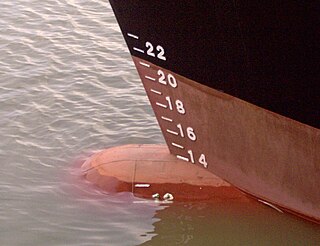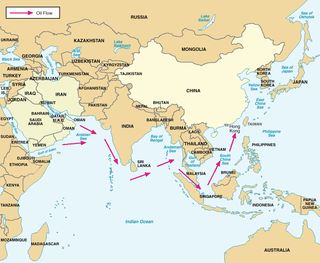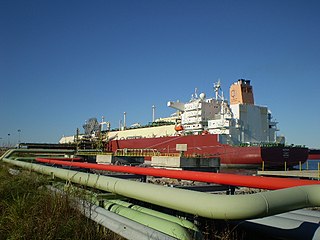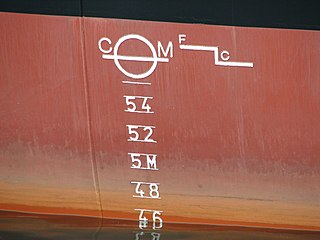 W
WA cargo ship or freighter is a merchant ship that carries cargo, goods, and materials from one port to another. Thousands of cargo carriers ply the world's seas and oceans each year, handling the bulk of international trade. Cargo ships are usually specially designed for the task, often being equipped with cranes and other mechanisms to load and unload, and come in all sizes. Today, they are almost always built by welded steel, and with some exceptions generally have a life expectancy of 25 to 30 years before being scrapped.
 W
WAir draft is the distance from the surface of the water to the highest point on a vessel. This is similar to the "deep draft" of a vessel which is measured from the surface of the water to the deepest part of the hull below the surface, but air draft is expressed as a height, not a depth.
 W
WThe angle of list is the degree to which a vessel heels to either port or starboard at equilibrium—with no external forces acting upon it.
 W
WAngle of loll is the state of a ship that is unstable when upright and therefore takes on an angle of heel to either port or starboard.
 W
WBaltimax is a naval architecture term for the largest ship measurements capable of entering and leaving the Baltic Sea in a laden condition.
 W
WThe beam of a ship is its width at its widest point. The maximum beam (BMAX) is the distance between planes passing through the outer extremeties of the ship, beam of the hull (BH) only includes permanently fixed parts of the hull, and beam at waterline (BWL) is the maximum width where the hull intersects the surface of the water.
 W
WCapesize ships are the largest dry cargo ships. They are too large to transit the Suez Canal or Panama Canal, and so have to pass either the Cape Agulhas or Cape Horn to traverse between oceans.
 W
WChinamax is a standard of ship measurements that allow conforming ships to use various harbours when fully laden, the maximum size of such a ship being 24 m (79 ft) draft, 65 m (213 ft) beam and 360 m (1,180 ft) length overall. An example of ships of this size is the Valemax bulk carriers.
 W
WDeadweight tonnage or tons deadweight (DWT) is a measure of how much weight a ship can carry. It is the sum of the weights of cargo, fuel, fresh water, ballast water, provisions, passengers, and crew.
 W
WThe displacement or displacement tonnage of a ship is its weight. As the term indicates, it is measured indirectly, using Archimedes' principle, by first calculating the volume of water displaced by the ship, then converting that value into weight. Traditionally, various measurement rules have been in use, giving various measures in long tons. Today, metric tonnes are more commonly used.
 W
WThe draft or draught of a ship's hull is the vertical distance between the waterline and the bottom of the hull (keel). Draft determines the minimum depth of water a ship or boat can safely navigate.
 W
WIn sailing and boating, a vessel's freeboard is the distance from the waterline to the upper deck level, measured at the lowest point of sheer where water can enter the boat or ship. In commercial vessels, the latter criterion measured relative to the ship's load line, regardless of deck arrangements, is the mandated and regulated meaning.
 W
WGross tonnage is a nonlinear measure of a ship's overall internal volume. Gross tonnage is different from gross register tonnage. Neither gross tonnage nor gross register tonnage should be confused with measures of mass or weight such as deadweight tonnage or displacement.
 W
WHandymax and Supramax are naval architecture terms for the larger bulk carriers in the Handysize class. Handysize class consists of Supramax, Handymax, and Handy. The ships are used for less voluminous cargoes, and different cargoes can be carried in different holds. Larger capacities for dry bulk include Panamax, Capesize and Very Large Ore Carriers and Chinamax.
 W
WHandysize is a naval architecture term for smaller bulk carriers or oil tanker with deadweight of up to 50,000 tonnes, although there is no official definition in terms of exact tonnages. Handysize is also sometimes used to refer to the span of up to 60,000 tons, with the vessels above 35,000 tonnes referred to as Handymax or Supramax.
 W
WA hull is the watertight body of a ship or boat. The hull may open at the top, or it may be fully or partially covered with a deck. Atop the deck may be a deckhouse and other superstructures, such as a funnel, derrick, or mast. The line where the hull meets the water surface is called the waterline.
 W
WLength between perpendiculars is the length of a ship along the summer load line from the forward surface of the stem, or main bow perpendicular member, to the after surface of the sternpost, or main stern perpendicular member. When there is no sternpost, the centerline axis of the rudder stock is used as the aft end of the length between perpendiculars.
 W
WLength overall is the maximum length of a vessel's hull measured parallel to the waterline. This length is important while docking the ship. It is the most commonly used way of expressing the size of a ship, and is also used for calculating the cost of a marina berth.
 W
WMalaccamax is a naval architecture term for the largest tonnage of ship capable of fitting through the 25-metre-deep (82 ft) Strait of Malacca. Bulk carriers and supertankers have been built to this tonnage, and the term is chosen for very large crude carriers (VLCC). They can transport oil from Arabia to China. A typical Malaccamax tanker can have a maximum length of 333 m (1,093 ft), beam of 60 m (197 ft), draught of 20.5 m (67.3 ft), and tonnage of 300,000 DWT.
 W
WThe metacentric height (GM) is a measurement of the initial static stability of a floating body. It is calculated as the distance between the centre of gravity of a ship and its metacentre. A larger metacentric height implies greater initial stability against overturning. The metacentric height also influences the natural period of rolling of a hull, with very large metacentric heights being associated with shorter periods of roll which are uncomfortable for passengers. Hence, a sufficiently, but not excessively, high metacentric height is considered ideal for passenger ships.
 W
WPanamax and New Panamax are terms for the size limits for ships travelling through the Panama Canal. The limits and requirements are published by the Panama Canal Authority (ACP) in a publication titled "Vessel Requirements". These requirements also describe topics like exceptional dry seasonal limits, propulsion, communications, and detailed ship design.
 W
WNet tonnage is a dimensionless index calculated from the total moulded volume of the ship's cargo spaces by using a mathematical formula. Defined in The International Convention on Tonnage Measurement of Ships that was adopted by the International Maritime Organization in 1969, the net tonnage replaced the earlier net register tonnage (NRT) which denoted the volume of the ship's revenue-earning spaces in "register tons", units of volume equal to 100 cubic feet (2.83 m3). Net tonnage is used to calculate the port duties and should not be taken as less than 30 per cent of the ship's gross tonnage.
 W
WPanamax and New Panamax are terms for the size limits for ships travelling through the Panama Canal. The limits and requirements are published by the Panama Canal Authority (ACP) in a publication titled "Vessel Requirements". These requirements also describe topics like exceptional dry seasonal limits, propulsion, communications, and detailed ship design.
 W
WQ-Max is a type of ship, specifically a membrane type liquefied natural gas carrier. In the name Q-Max, "Q" stands for Qatar and "Max" for the maximum size of ship able to dock at the LNG terminals in Qatar. Ships of this type are the largest LNG carriers in the world.
 W
WThe term Seawaymax refers to vessels which are the maximum size that can fit through the canal locks of the St. Lawrence Seaway, linking the inland Great Lakes of North America with the Atlantic Ocean.
 W
W"Suezmax" is a naval architecture term for the largest ship measurements capable of transiting the Suez Canal in a laden condition, and is almost exclusively used in reference to tankers. The limiting factors are beam, draft, height, and length.
 W
WThe twenty-foot equivalent unit is an inexact unit of cargo capacity, often used for container ships and container ports. It is based on the volume of a 20-foot-long (6.1 m) intermodal container, a standard-sized metal box which can be easily transferred between different modes of transportation, such as ships, trains, and trucks.
 W
WAn oil tanker, also known as a petroleum tanker, is a ship designed for the bulk transport of oil or its products. There are two basic types of oil tankers: crude tankers and product tankers. Crude tankers move large quantities of unrefined crude oil from its point of extraction to refineries. For example, moving crude oil from oil wells in a producing country to refineries in another country. Product tankers, generally much smaller, are designed to move refined products from refineries to points near consuming markets. For example, moving gasoline from refineries in Europe to consumer markets in Nigeria and other West African nations.
 W
WThe waterline is the line where the hull of a ship meets the surface of the water. Specifically, it is also the name of a special marking, also known as an international load line, Plimsoll line and water line, that indicates the draft of the ship and the legal limit to which a ship may be loaded for specific water types and temperatures in order to safely maintain buoyancy, particularly with regard to the hazard of waves that may arise. Varying water temperatures will affect a ship's draft, because warm water is less dense than cold water, providing less buoyancy. In the same way, fresh water is less dense than salinated or seawater with the same lessening effect upon buoyancy.
 W
WA vessel's waterline length is the length of a ship or boat at the level where it sits in the water. The LWL will be shorter than the length of the boat overall as most boats have bows and stern protrusions that make the LOA greater than the LWL. As a ship becomes more loaded, it will sit lower in the water and its ambient waterline length may change; but the registered L.W.L it is measured from a default load condition.